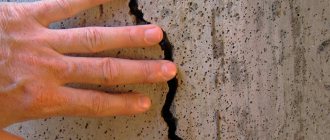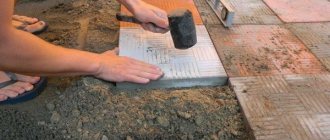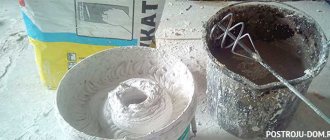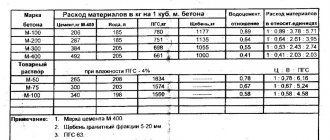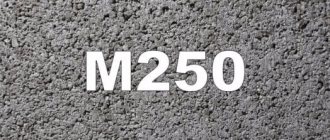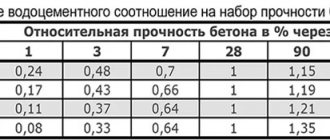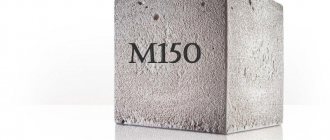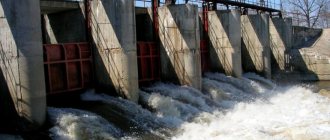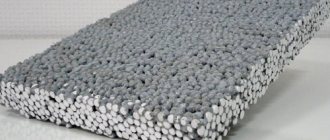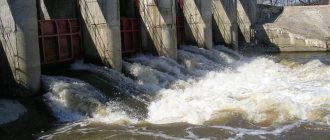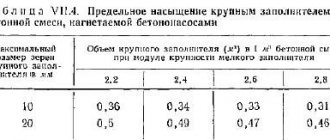Heavy and lightweight concrete: comparative characteristics
Heavy concrete differs from light concrete primarily in density. For the first, this figure varies from 1800 to 2500 kg/m3. Lightweight concrete is characterized by a density of 600-1800 kg/m3. The difference in this value is achieved due to the type of components used in the manufacture of the concrete mixture.
When mixing heavy concrete, cement, dense aggregates, and water are traditionally used. Granite crushed stone of fraction 5 20 or gravel is used as a coarse aggregate; sand of medium fraction is used as a fine aggregate. All of them together form a dense structure, and when hardened, they form a hard stone with high strength.
Unlike heavy concrete, lightweight concrete has a cellular structure, which is formed as a result of the use of porous aggregates (expanded clay, limestone, pumice, tuff) or special fillers. The latter, as a rule, are of inorganic origin. When they interact with the binder component, oxygen is released, due to which a porous structure is formed in lightweight concrete.
Strength of heavy concrete, factors affecting strength
Compressive strength is the main indicator of the mechanical properties of concrete. It is determined by the compressive strength of standard cube samples made from a given concrete mixture and aged for 28 days.
In terms of compressive strength, the following grades have been established for heavy concrete: M200, M250, MZOO, M350, M400, M450, M500, M600, M700, M800. The main factors influencing the strength of concrete are the activity of cement and the mass ratio of water and cement (water-cement ratio W/C or its inverse cement-water ratio - C/W). The dependence of the strength of ordinary concrete on the C/V and grade of cement is generally expressed by the Bolomey-Skramtaev formula:
1) for ordinary concrete (C/V<=2.5) Rb = A Rc (C/V - 0.5);
2) for high-strength concrete (C/V>2.5) Rb = A1 Rc (C/V + 0.5);
where Rb is the strength of concrete at the age of 28 days. when hardening under normal conditions, MPa;
Rc—cement activity, MPa; A(A1) - coefficients taking into account the quality of aggregates and binders (for high quality -0.65 (0.43), for ordinary -0.6 (0.4), for low quality -0.55 (0.37)) .
The strength of concrete is influenced by the grain composition of the aggregates and the correct mixing of its components. The strength of concrete is significantly influenced by the degree of compaction of the concrete mixture, the duration and conditions of concrete hardening. Well-compacted concrete under favorable temperature and humidity conditions continuously gains strength over a number of years.
Moreover, in the first 7-10 days. the strength of concrete increases quite quickly, then the strength increases by 28 days. slows down and attenuates at the age of over 1 year, at 7 days of age they have an average strength equal to 60 - 70% of the 28-day (brand) strength, at the age of 180 days, 1 year and 2 years their strength is 150, 175 and 200% brand strength. Strength of concrete at age n
:
Rn=R28· (Lg n / Lg 28) , where 90 > n
≥ 3
days.
Properties of heavy concrete: porosity, frost resistance, water resistance, heat generation, shrinkage and swelling.
The average density of heavy concrete ranges from 1800-2500 kg/m3 and depends on the average density of aggregates.
Porosity. Concrete is not an absolutely dense body. Pores, at least in very small quantities, will be located inside the aggregate particles, in the cement stone, between the aggregate and the cement stone. The porosity of heavy concrete ranges from 6 to 15% depending on the type of aggregates, concrete composition and compaction methods. The nature of porosity is of great importance: large open pores worsen the properties of concrete, small closed ones (when using plasticizing and hydrophobic additives) improve the properties of concrete.
The frost resistance of heavy concrete can range from 50 to 300, frost resistance grades - 50, 100, 150, 200, 300. The frost resistance of concrete depends on the nature and magnitude of concrete porosity, the type of cement and aggregates. The heat resistance of heavy concrete is low. It can be used for structures exposed to prolonged heating to temperatures not exceeding 200° C. In this case, the strength is reduced by 30-50%, which must be taken into account when designing the concrete composition.
Deformability of concrete. In concrete, there are two types of deformations: volumetric
, developing in all directions under the influence of shrinkage, changes in temperature and humidity;
force , developing mainly along the direction of action of forces. Starting from small stresses, in addition to elastic recovering deformations, inelastic residual deformations develop in it. Therefore, force deformations, depending on the nature of the application of the load and the duration of its action, are divided into three types: with a single load and a short-term load, with a long-term load and with repeated repeated load action.
When concrete is loaded once with a short-term load, concrete deformation is formed from elastic and inelastic plastic deformations. A small proportion of inelastic deformations is restored over a period of time after unloading. The property of concrete, characterized by an increase in inelastic deformations under long-term load action, is called creep .
Creep deformations can be 3-4 times higher than elastic deformations. The creep of concrete in a dry environment is much greater than in a wet environment. Technological factors influence the creep of concrete: with an increase in W/C and the amount of cement per unit volume of concrete mixture, creep increases; with increasing strength of aggregate grains, creep decreases; with increasing concrete strength, creep decreases.
Deformation of concrete under repeated load action. Repeated repetition of loading and unloading cycles of concrete leads to a gradual accumulation of inelastic deformations. After a sufficiently large number of cycles, these inelastic deformations corresponding to a given stress level are gradually selected, creep reaches its limiting value, and the concrete begins to work elastically. At high stresses, after a certain number of cycles, inelastic strains begin to increase without limit, which leads to destruction of the sample.
Application of heavy and light concrete
Heavy concrete has high strength and long service life. Therefore, it is widely used in the manufacture of foundations, load-bearing structures, road surfaces, various reinforced concrete products, etc. This building material has high frost resistance and water resistance. Low abrasion makes it possible to make paving slabs, steps, road and airfield slabs, and curbs from heavy concrete.
Lightweight concrete, due to its low weight, high noise and thermal insulation, is used for the construction of enclosing structures of residential and public buildings. A house built on lightweight concrete is able to “breathe”. In winter, such a room is warm, and in the summer heat it is cool.
As a rule, lightweight concrete is used in monolithic form, or for the manufacture of wall blocks (foam blocks, gas blocks, expanded clay blocks). Unlike heavy concrete, lightweight concrete is easy to drill, saw, and groove. The construction of walls from such blocks can be carried out using special glue, due to which a minimal masonry joint is formed.
FILLERS
Fillers serve to create the skeleton of the hole. By density, aggregates are divided into light ones with cj less than 1000 kg/m3 and heavy ones with medium density. Light ones include slag, pumice, asbestos, tripoli and other native sands and crushed rocks.For ordinary plasters as a filler (natural, artificial).
Natural sand is a product formed during the destruction of hard rocks. By the look! mountain (gully), river, sea and dune lakes expect to be unpolluted and contain a small amount of
For the preparatory layer of plaster, the maximum amount of sand should be 2.5 mm, the elutriation content should be more than 15 °/o by weight, the content of water-soluble < stoacid compounds in terms of BOZ - 2%. For Dl5, sand with a grain size of no more than 1.2 m is used; tormented impurities are no more than 5 °/o, water-soluble low-acid compounds - 2%.
In mortars, sand is used as an inert. When used in mortars as a binder for cements, sand as a filler can contain no more than 15% by weight of sand. More content; affects the adhesion of individual elements in solution
To prepare solutions, you can mix them together. The best mixtures are those with a content of 37-40% in sand. For solutions, perekagam, the average size of sand grains should be within the range
Artificial sands are a product of crushing, modified) type (granites, marbles, limestones, tuffs, pumice! slags of various densities and origins and i the performance of decorative and special plaster (covering layer.
In special plasters, artificial sand threads are used for all layers of plaster. Coarse sands for mortars for various purposes should be specified by design. But usually it is equal to the size of natural sands.
When making sand from slag, it is better to use coal slag with a low content of sulfur, unburned particles and rocks
When performing special plasters and especially decorative ones,
in addition to sand obtained from rocks and slag, you can use
also crushed stone, chips and powder from these rocks.
Crushed stone is used primarily as a surface layer of decorative plaster (powdering on fresh mortar, laying it on together with a binder and subsequent processing, etc.). The most widely used crushed stone is made from colored durable rocks. The size of crushed stone is dictated by architectural considerations.
The crumb is used in solutions for decorative plaster as a filler in the covering layer or as a powder (laying) over a freshly laid mortar. The most commonly used are marble, granite and glass chips.
For solutions of decorative plasters, marble chips with a grain size of 0.3 to 5.0 mm are used.
Glass chips are small grains of suppressed opaque glass, fraction 1.25-2.5 mmg. Available in white, light green, blue and other colors. It is supplied in paper bags.
Both crushed stone and crumbs should not contain more than 1% of dusty clay particles. Water absorption for decorative mortar fillers should not exceed 12%.
Powder (marble, lime, tuff) is a product of fine grinding of rocks (with a residue on a sieve of 3200 holes/cm2 of no more than 2-4%). It is used as a filler for coloring cement in solutions of decorative plasters.
Asbestos is used as a filler in the form of mineral fiber or crumbs. Lower grades of asbestos (5th, 6th and asbestos powder), introduced into the solution for plasters, produce non-thermally conductive and fire-retardant plasters.
Barite sand and barite dust are obtained by crushing particularly heavy rocks (barite) and are used in solutions for X-ray protective plasters. The grain size of barite sand is no more than 1.25 mm, the average density is 2400 kg/m3. Barite dust must pass without residue through a sieve of 400 holes/cm2. Average dust density is 2000 kg/m3. The content of barium sulfate in sand and dust must be at least 85%.
Buy heavy or light concrete inexpensively
sells heavy and light concrete of various brands. Our products are distinguished by high quality characteristics, confirmed by relevant documents. Check out the full range of concrete grades offered and their prices on our website, or by calling the number below.
In addition to concrete production, we also deliver it. We have dump trucks and mixers with a capacity of up to 7 cubic meters. You can order equipment at a time convenient for you, and we will organize its timely delivery to the final point of concrete unloading. Cooperation with means an affordable price per cube of concrete, constant production volumes, and a guarantee of the quality of the material.
Basic properties of heavy concrete
The main properties of heavy concrete, in addition to strength, include porosity, deformability (modulus of elasticity, creep, shrinkage), water permeability, frost resistance, thermophysical properties, etc.
Deformability of concrete. Concrete under load behaves not like a perfectly elastic body (for example, glass), but like an elastoviscoplastic body. At low stresses (no more than 0.2 of the ultimate strength), concrete deforms as an elastic material. Moreover, its initial modulus of elasticity depends on porosity and strength and is for heavy concrete (2.2...3.5) * 10 MPa (for highly porous cellular concrete the elastic modulus is about 1 -10 MPa).
At high stresses, plastic (residual) deformation begins to appear, developing as a result of the growth of microcracks and plastic deformations of the gel component of the cement stone.
Creep is the tendency of concrete to increase plastic deformations under prolonged exposure to static load. Creep of concrete is also associated with the plastic properties of the cement gel and microcrack formation. It has a decaying character over time. The absolute values of creep depend on many factors. Creep develops especially actively if concrete is loaded at an early age. Creep can be assessed in two ways: as a positive process, helping to reduce stresses arising from thermal and shrinkage processes, and as a negative phenomenon, for example, reducing the effect of prestressing reinforcement.
Shrinkage is the process of reducing the size of concrete elements during their hardening and further work when they are in air-dry conditions. The main reason for shrinkage is the compression of the gel component of the cement stone during drying. The higher the volume of cement paste in concrete, the higher the shrinkage of concrete. On average, the shrinkage of heavy concrete is 0.3...0.4 mm/m.
Due to concrete shrinkage, large shrinkage stresses can arise in concrete and reinforced concrete structures; therefore, long elements are cut with shrinkage joints to avoid the appearance of cracks. If concrete shrinkage is 0.3 mm/m in a structure 30 m long, the total shrinkage will be 10 mm. Shrinkage cracks in concrete at the contact with the aggregate and in the cement stone itself can reduce frost resistance and serve as sources of concrete corrosion.
Porosity. As strange as it may seem, concrete, a seemingly dense material, has noticeable porosity. The reason for its occurrence is an excessive amount of mixing water. The concrete mixture, after proper placement, is a dense body consisting of cement, water and aggregates. During hardening, part of the water is chemically bound by the minerals of the cement clinker (for Portland cement, about 0.2 by weight of cement), and the remaining part gradually evaporates, leaving behind pores.
Water absorption characterizes the ability of concrete to absorb moisture in a drop-liquid state; it depends mainly on the nature of the pores. The greater the number of capillary interconnected pores in the concrete, the greater the water absorption. The maximum water absorption of heavy concrete with dense aggregates reaches 4...8% by weight (10...20% by volume). For lightweight and cellular concrete this figure is significantly higher.
High water absorption negatively affects the frost resistance of concrete. To reduce water absorption, they resort to hydrophobization of concrete, as well as to install vapor and waterproofing of concrete structures.
The water permeability of concrete is determined mainly by the permeability of the cement stone and the contact zone “cement stone - aggregate”; In addition, microcracks in the cement stone and defects in the adhesion of reinforcement to concrete can be the paths for filtration of liquid through concrete. The high water permeability of concrete can lead to its rapid destruction due to corrosion of the cement stone.
To reduce water permeability, it is necessary to use fillers of appropriate quality (with a clean surface), as well as use special sealing additives (liquid glass, ferric chloride) or expanding cements. The latter are used for concrete waterproofing.
Based on water resistance, concrete is divided into grades W0.2; W0.4; W0.6; W0,8 and Wl,2. The mark indicates the water pressure (MPa) at which a 15 cm high cylinder sample does not allow water to pass through during standard tests.
Frost resistance is the main indicator that determines the durability of concrete structures in our climate. The frost resistance of concrete is assessed by alternately freezing at minus (18 ± 2) ° C and thawing in water at (18 + 2) C, samples of the tested concrete previously saturated with water. The duration of one cycle is 5... 10 hours depending on the size of the samples.
The frost resistance grade is taken to be the greatest number of “freezing-thawing” cycles that the samples can withstand without reducing the compressive strength by more than 5% compared to the strength of the control samples at the beginning of the tests. The following frost resistance grades of concrete have been established: F25; F35; F50; F75; F100…F1000. The standard also provides for accelerated test methods: in a salt solution or deep freezing to minus (50 ± 5) C. The reason for the destruction of concrete under the conditions under consideration is capillary porosity. Water enters the concrete through capillaries and, freezing there, gradually destroys its structure.
To obtain concrete with high frost resistance, it is necessary to achieve a minimum capillary porosity (not higher than 0.6%).
This is possible by reducing the water content in the concrete mixture, which, in turn, is achieved by using: – rigid concrete mixtures, intensively compacted during laying; – plasticizing additives that increase the workability of concrete mixtures without adding water.
There is another way to increase the frost resistance of concrete - hydrophobization (volumetric or surface); in this case, the water absorption of concrete decreases and, accordingly, its frost resistance increases.
Thermophysical properties. Of these, the most important are thermal conductivity, heat capacity and temperature deformation.
The thermal conductivity of heavy concrete, even in an air-dry state, is high - about 1.2...1.5 W/(m * K), i.e. 1.5...2 times higher than that of brick. Therefore, heavy concrete can only be used in enclosing structures in conjunction with effective thermal insulation. Lightweight concrete (see clause 12.7), especially cellular concrete, has a low thermal conductivity of 0.1...0.5 W/(m * K), and their use in enclosing structures is preferable.
The heat capacity of heavy concrete, like other stone materials, is in the range of 0.75...0.92 J/(kg * K); on average - 0.84 J/(kg * K).
Temperature deformations. Temperature coefficient of linear expansion of linear expansion coefficient of linear expansion of heavy concrete (10…12) * 10 K1. This means that with an increase in concrete temperature by 50° (for example, from -20 to +30 °C), the expansion will be approximately 0.5 mm/m. Therefore, in order to avoid cracking, long-term structures are cut with expansion joints.
Large temperature fluctuations can cause internal cracking of concrete due to the different thermal expansion of coarse aggregate and cement stone.
=12=
1. High-strength B. Grades 600...1000, obtained on the basis of high-strength PC, washed sand and crushed stone grades 1200...1400, w/c 10 days in air without watering at 15-20°C. After hardening, it is recommended to moisten surface B with sulfuric acid solution. This B is used as a protective layer for reinforced concrete and metal.
=13=
studfiles.net
Concrete for reinforced concrete structures
In reinforced concrete structures (RCS) used in modern construction, concrete is divided into the following types:
- Heavy. This type of concrete with a dense structure is made using cement as a binder and coarse-grained dense aggregates. It hardens under any conditions and has an average density of 2200-2500 kg/cub.m;
- Fine grained. This type of heavy concrete with a dense structure is made using cement as a binder and fine aggregates. It hardens under any conditions and has an average density of more than 1800 kg/cub.m;
- Easy. This type of coarse concrete with a dense porous structure is made using cement as a binder and porous aggregates. It hardens under any conditions. When its basic physical properties coincide with heavy concrete, it is used together with it.
- Cellular. This type of concrete hardens when special treatment is applied.
- Special tensile concrete.
For what reason are light and lightweight types of concrete used when creating reinforced concrete structures? Among the main advantages of their use, modern builders cite the following capabilities:
- reduction by 25-40% of the mass of reinforced concrete;
- reduction in the cost of reinforced concrete structures;
- improving the soundproofing characteristics of reinforced concrete concrete;
- increasing the heat-shielding characteristics of reinforced concrete structures;
- increasing the seismological stability of reinforced concrete structures;
- increasing the fire resistance of reinforced concrete concrete.
Lightweight, cellular and porous types of concrete with an average density of less than 1400 kg/m3 are used to create reinforced concrete fences. Dense fine-grained ones can be used together with heavy types, as a filler for joints and seams of reinforced concrete concrete. Particularly heavy ones are used in the construction of special facilities, including military bunkers and nuclear power plants. The average density of concrete used at such facilities is more than 2500 kg/cub.m.
Classifying characteristics
The physical and mechanical characteristics of concrete are directly influenced by:
- preparation method;
- type of binder;
- type of coarse aggregate;
- type of fine aggregate;
- water.
These characteristics are determined by the structure of the material, which creates certain conditions for its hardening.
Taking into account the requirements for basic physical properties, concrete is classified in the following areas:
I. Structure
Divided into:
- dense concrete - all the free space between the aggregate substances is occupied by a hardened binder;
- large-porous - the free space between the aggregate substances is not completely occupied by the hardened binder (usually there is little or no sand in it);
- porous - in the free space between the filler substances there is a hardened binder with special additives, as a result of which specific pores are formed;
- cellular - artificial closed pores are created in the free space between the filler substances.
The strength of concrete directly depends on the increase in the density of its structure. The manufacturer can select the density required by the customer using:
- choosing the optimal grain composition;
- mechanical additional compaction of the concrete mixture during production;
- using more cement;
- changes in the water/cement ratio in concrete.
A higher grade of cement requires less of it to achieve the required concrete strength.
II. Density
It is measured by the ratio of the mass of a material per unit volume. According to the degree of average density, it is divided into the following categories:
- especially heavy – more than 2500 kg/cub.m;
- heavy – 2200-2500 kg/cub.m;
- lightweight – 1800-2200 kg/cub.m;
- light – 500-1800 kg/cub.m.
III. Type of binder in concrete
Modern manufacturers use various substances as a binder, according to which it is divided into the following types:
- cement;
- polymer cement;
- silicate on lime;
- plaster;
- mixed;
- special using a variety of additives.
IV. Type of filler
The following are used as filler in production:
- dense natural material (gravel or crushed rock, quartz sand);
- porous natural material (perlite, pumice, shell rock);
- artificial material (expanded clay, slag);
- a special material that ensures concrete resistance to various thermal and chemical influences.
Crushed stone is a cheaper material that can more quickly provide a given strength.
Concrete is also divided into types based on the porous aggregate used in it:
- expanded clay concrete;
- slag concrete;
- perlite concrete;
- pumice concrete and others.
V. Grain composition
Divided into the following types:
- coarse-grained, in which large and fine aggregates are used;
- fine-grained, in which only fine aggregates are used.
VI. Curing conditions
Divided into the following categories:
- natural hardening;
- subjected to treatment under atmospheric pressure with heat and moisture;
- autoclaved under high pressure conditions.
